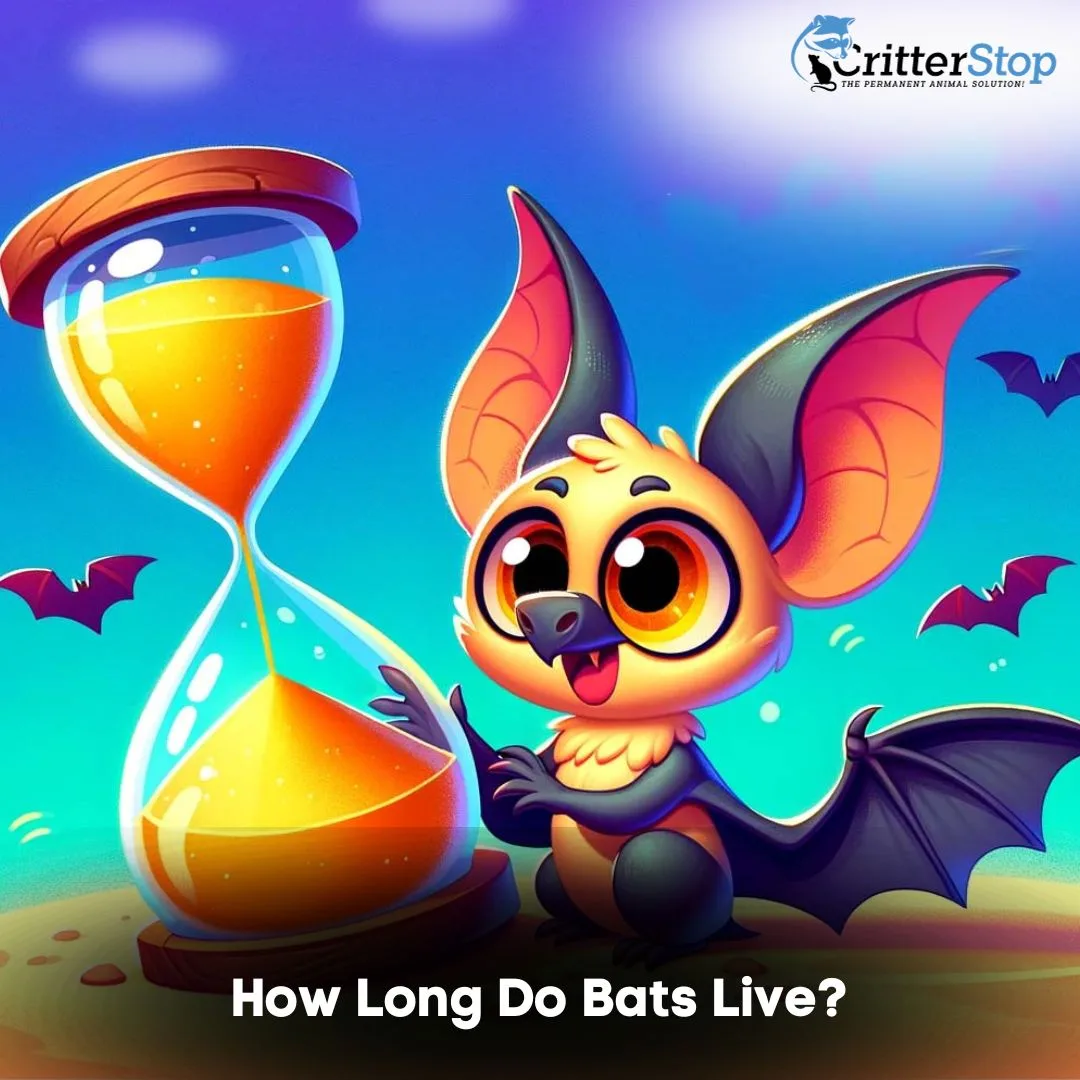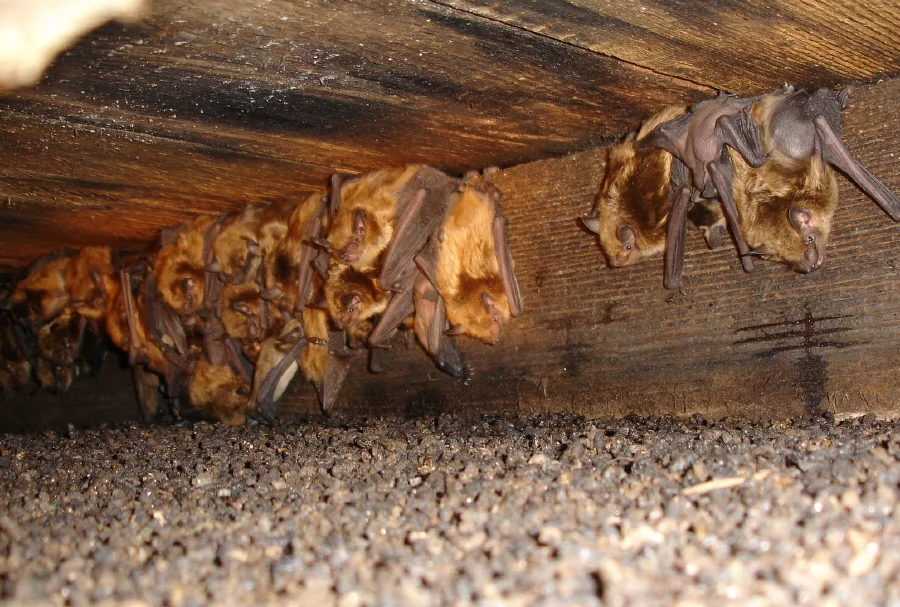
When the sun dips below the horizon and the world cloaks itself in darkness, there's a group of creatures that emerge to captivate our imaginations. These are none other than bats, the enigmatic nocturnal wonders. With their unique physiology and behavior, bats have cast a spell on our curiosity, drawing us into the mesmerizing world of the night flyers.
Imagine soaring through the inky blackness, relying on echolocation to navigate with pinpoint precision, or hanging upside-down in caves, defying gravity as if it were a mere suggestion. Bats seem like characters straight out of a fantasy novel, but they are very much real and inhabit every corner of our globe. Join our experts in wildlife removal from Critter Stop in this bat-journey!

While the allure of bats' mystique is undeniable, their significance transcends mere fascination. These aerial acrobats play pivotal roles in our ecosystems, offering services that often go unnoticed. From the moment they take flight, bats embark on a mission to maintain ecological harmony.
Picture this: as the night unfolds, bats swoop down like stealthy superheroes, performing critical roles in pest control. They are the silent defenders of our gardens, feasting on insects with a voracious appetite. Mosquitoes, moths, and countless other pesky bugs find themselves on the menu, reducing the need for chemical pesticides and making our lives more comfortable.
But bats don't stop at insect control. They moonlight as pollinators, too, adding yet another layer to their eco-heroism. Certain species have developed a taste for nectar and pollen, inadvertently transferring the life-giving essence of plants as they seek their nocturnal sustenance. Without bats, some plant species would struggle to reproduce, and the delicate balance of nature would be at risk.
So, next time you see bats flit across the moonlit sky or hear their high-pitched calls in the night, remember that you're witnessing not just enigmatic creatures but essential players in the grand ecological symphony. As we delve deeper into the world of bats, you'll discover the secrets of their adaptations, lifestyles, and the incredible diversity that makes them a fascinating subject of study and admiration.
In the animal kingdom, there's a select group only mammals that boasts the extraordinary ability to take to the skies. Birds, insects, and...bats! Yes, bats are the mavericks of the mammal world, holding the title of the only true flying mammals. With their agile wings, they soar through the darkness, defying gravity with a grace that's nothing short of astonishing.
Picture this: while most mammals are confined to the solid ground or paddling through water, bats effortlessly traverse the air, exploring realms others can only dream of. Their wings, composed of elongated fingers covered in a delicate membrane, are both an engineering marvel and a work of art. These "chiropteran" wings allow them to fly and perform intricate aerial maneuvers, all while being the envy of other mammals.
Now, let's talk about the sheer spectacle that is bat diversity. Around the world, these night flyers have evolved into a mind-boggling array of species, each with its own unique quirks and habits. It's as if Mother Nature decided to experiment with bat blueprints, creating a truly extraordinary menagerie.
In the tropical rainforests, you'll encounter fruit bats, also known as flying foxes, with their impressive wingspans and a penchant for fruits. They look more like furry kite enthusiasts than conventional bats!
On the other end of the spectrum are the tiny bumblebee bats, barely larger than a thumb. These little dynamos are the smallest mammals globally, and their miniature size doesn't deter them from conquering the night skies.

And don't forget the common vampire bat or bats, the famous bloodsuckers of folklore. These bats have an unexpected taste for the red stuff, yet their social behavior and unique adaptations are equally enthralling.
As we dive deeper into the world of bats, you'll discover the incredible stories behind these diverse species, their astonishing abilities, and the vital roles they play in ecosystems worldwide. Buckle up, because our bat adventure is just taking flight!
Just like any other creature, bats experience the remarkable journey of life, from the tender moments of birth to the wisdom of old age. Their lifecycle is a captivating saga that unfolds through distinct stages, each with its own set of challenges and triumphs.
It all begins with the birth of a bat pup, a moment of vulnerability that contrasts with their eventual mastery of the night skies. As the pups grow, they enter adolescence, where they learn the art of flight and hone their echolocation skills, essential for hunting in the dark.
As they reach maturity, bats take on vital roles in their colonies, participating in the intricate dance of social life and reproduction. Finally, in the twilight of their last years in the wild, they accumulate wisdom and experience that benefits their communities.
While the solitary image of a bat in flight is captivating, the true magic of bat life is often found in the heart of their colonies. Here, bats display exceptional levels of maternal care that are nothing short of awe-inspiring.
Bat colonies, where hundreds or even thousands of bats gather, serve as bustling hubs of activity. Within these tight-knit communities baby bats, maternal care takes center stage. Female bats tend to their pups with utmost devotion, providing nourishment and protection. It's a sight to behold as mother bats dote on their youngsters, ensuring their survival in the intricate world of the night.
These colonies become schools of life where young bats learn the ropes of bat existence. They pick up essential skills like hunting, navigation, and social etiquette, all while forming bonds that will last a lifetime. So, the next time you picture a baby bat somewhere, don't forget to envision the bustling colony life and the profound maternal care that sustains these remarkable creatures.

Despite their mastery of the night skies, bats aren't invincible. They have their own rogues' gallery of adversaries, the most prominent being owls, snakes, and birds of prey. These stealthy hunters lurk in the darkness, waiting for an opportunity to swoop down on unsuspecting bats.
Imagine an owl silently gliding through the night, its keen eyes locked onto a bat in mid-flight. It's a thrilling and perilous dance that unfolds in the inky blackness, where the outcome is uncertain. These natural predators are an ever-present threat in the bat's world, adding a layer of complexity to their survival story.
In the annals of bat history, there's a tragic chapter written most bat species in the form of White-Nose Syndrome. This devastating disease has wreaked havoc on bat populations in various regions, causing widespread concern among bat enthusiasts and conservationists.
White-Nose Syndrome, caused by a fungus, disrupts the hibernation patterns of bats worldwide. It leads to increased energy expenditure during the critical winter months when food is scarce. The result? Weakened bats that often perish before spring arrives. It's a stark reminder of how vulnerable even the most resilient creatures can be in the face of emerging diseases.
Beyond direct threats, bats face a multitude of environmental challenges that impact their lifespans. Habitat loss, driven by urbanization and deforestation, leaves bats with fewer places to roost and feed. Climate change alters the availability of their prey, making survival a tougher battle.
Human disturbances, such as the noise and light pollution from our cities, disrupt the nocturnal world that bats rely on. It's akin to trying to sleep with a concert in your backyard - not easy for creatures whose existence is tightly woven into the fabric of the night.
But here's where bats reveal their remarkable adaptations. Their unique physiology allows them to thrive despite these challenges. Bats possess slow metabolisms, which means they use energy more efficiently, making the most of every meal.
Some bat species also enter a state of hibernation or torpor during the cold months, reducing their metabolic rate to a bare minimum. It's like hitting the pause button on life, allowing them to conserve precious energy until spring's warmth returns.
So, while bats face an array of threats, their evolutionary innovations give most bats them a fighting chance.
In the world of bat longevity, one species shines brightly despite its diminutive stature. Enter the little brown bat, a true marvel of nature. This small bat defies expectations by living exceptionally long for its size. It's like finding a tiny, ageless wizard in a world of ordinary creatures.
With their dainty wings and fuzzy appearance, little brown bats might appear delicate, but they've mastered the art of longevity. These bats have been known to gracefully dance through the night skies for several decades, displaying the incredible resilience hidden within their petite frames.
But if we're talking about the ultimate record holder in the bat longevity department, the crown goes to Brandt's bat. This remarkable species has etched its name into the record books as the bat with the longest lifespan. It's as if these bats have found the secret to eternal youth in the depths of the night.
Brandt's bats can amaze us with their ability to live for many years, showcasing that age is just a number, even in the world of winged wonders.
Now, when we pit bat lifespans against those of other small mammals, the results are nothing short of astonishing. Bats, despite their nighttime adventures and unique lifestyles, often outlive their mammalian counterparts of similar size. It the bat's long lifespan seems like a bat-sized challenge to our preconceived notions of what it means to be a small, furry creature.
Whether it's the little brown bat's endurance or Brandt's bat's record-breaking lifespan of six species, these creatures challenge our understanding of the natural world.
The bats' journey towards longevity faces numerous obstacles in the modern world. However, there's hope on the horizon, thanks to dedicated conservationists who are taking action to safeguard bat populations. They're working tirelessly to protect bat habitats and reduce the impact of human-induced threats.
Imagine teams of passionate individuals working to preserve the caves and roosting sites that bats depend on. They're like guardians of the night, ensuring that these winged wonders have safe havens to rest and raise their young. Additionally, efforts are underway to minimize the use of harmful pesticides that can harm both bats and their insect prey.
In the world of bat conservation, there are real-life heroes who come to the rescue when bats are in distress. Organizations like Bat Conservation International are champions of bat survival. They provide resources, conduct research, and advocate for the protection of bat species worldwide.
Then there are the unsung heroes - wildlife rehabilitators. These dedicated individuals specialize in caring for injured or orphaned bats. They nurture these delicate creatures back to health, ensuring they can return to the wild where they belong. It's like a bat version of the Avengers, with each member playing a vital role in the battle for bat survival.
The combined efforts of these conservation warriors are making a substantial impact on bat longevity. They're not just safeguarding the future of bats; they're also preserving the delicate balance of ecosystems that rely on these night flyers.
In the realm of popular culture, bats have sometimes been portrayed as immortal beings, shrouded in an aura of eternal life. It's a compelling notion, but like many myths, it's far from the truth. Bats, despite their fascinating abilities and remarkable lifespans, are not immortal. They're extraordinary, but they're not ageless vampires of legend.
Debunking this myth reminds us that while bats are impressive creatures, they are still subject to the natural laws of life and death. Their longevity is a testament to their incredible adaptations and the vital roles they play in the ecosystems they inhabit.

Beyond the myths, it's crucial to illuminate the public about the real lifespans of bats and their indispensable roles in the natural world. Bats aren't eternal, but they are long-lived compared to humans and many other small mammals. This longevity allows them to make significant contributions to ecosystems as pollinators, insect controllers, and more.
Picture this: a world without bats. Mosquitoes run rampant, crops suffer from insect infestations, and some plants struggle to reproduce without their help. By understanding the true lifespans and ecological significance of bats, we come to appreciate their vital role in maintaining the delicate balance of nature.
Understanding the lifespan period of bats is crucial for homeowners in the North Texas area, especially when dealing with these creatures in your attic. Bats, while playing a vital role in our ecosystem, can be a cause for concern when they take up residence in our homes.
On average, bats have a surprisingly long lifespan for their body size. Most species can live for over 20 years, with some even reaching up to 30 years in the wild. This longevity is partly due to their flying ability, which allows them to escape many predators, and their hibernate habits, which reduce risks during colder months.
In North Texas, the most common species found in attics are the Mexican free-tailed bat and the Big Brown bat. These species typically live around 15 to 20 years. However, their presence in your attic is not just a temporary nuisance. Given their long lifespans and their reproductive abilities, bats can establish prolonged colonies if not addressed promptly.
As we draw the curtain on our bat odyssey, one thing becomes abundantly clear: bats are true marvels of the natural world. Their unique adaptations, longevity records, and vital roles in ecosystems illuminate a world of wonder that often goes unnoticed in the night.
These nocturnal wonders serve as nature's own pest control, pollinators, and guardians of the night. Their existence affects the health and balance of our planet's ecosystems, making them irreplaceable in the grand tapestry of life.
To ensure that the enchanting stories of bats continue for generations to come, we all have a part to play. By supporting conservation efforts and embracing a deeper understanding of these creatures, we become champions of the night alongside these extraordinary beings.
Imagine a world where bats thrive, where their ecological contributions are celebrated, and their mysteries are unraveled. It's a world where we recognize that the night skies are not empty but filled with the magic of these enigmatic night flyers.
So, let's join the bat brigade, spread the word about their importance, and actively support the preservation of their habitats. Together, we can ensure that the wondrous legacy of bats endures, painting our night skies with their graceful flight for generations to come.
Thanks for visiting our Critter Stop blog, we hope all this information can satisfy your curiosity and the way you see the bats! If you have any doubts about these animals, call us at (214) 234-2616. Hope to see you again around!
Visit our Critter Library and learn more about our furry friends